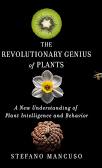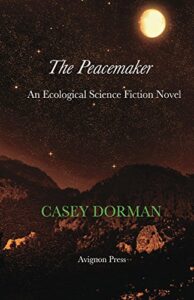Review of The Revolutionary Genius of Plants
by Stefano Mancuso.
Atria Books, New York: 2017
 A headline from the Washington Post this week saying, “Scientists inch closer to learning origins of mysterious ‘fairy circles’” caught my eye. Pictured above the article were a couple of, roughly round, barren circles in the Namibian desert, surrounded by grassy terrain. Other pictures showed thousands of such circles, which may be up to 20 meters across, more or less evenly spaced across the desert floor. Such circles, which are only present in the driest parts of the Namibian desert have puzzled scientists for years, but now may have an explanation. They are the surrounding plant life’s solution to limited water. Since there is not enough water to support a continuous ground cover in the desert, the grasses, which have long lateral roots, reach into the circular area, and suck out the moisture, preventing any grass from growing directly within the circle. Apparently, evenly spaced circles are the best mathematical solution to distributing water to the maximum number of desert plants. Stephan Getzin, an ecologist from the University of Gottingen, explains, “Researchers call this uniform design a turing pattern, which was first explained by mathematician Alan Turing.” Getzin goes on to say, “It’s not only animals which act as ecosystem engineers. Plants are doing the same thing. There’s increasing awareness that plants may be more intelligent than we believe.”
A headline from the Washington Post this week saying, “Scientists inch closer to learning origins of mysterious ‘fairy circles’” caught my eye. Pictured above the article were a couple of, roughly round, barren circles in the Namibian desert, surrounded by grassy terrain. Other pictures showed thousands of such circles, which may be up to 20 meters across, more or less evenly spaced across the desert floor. Such circles, which are only present in the driest parts of the Namibian desert have puzzled scientists for years, but now may have an explanation. They are the surrounding plant life’s solution to limited water. Since there is not enough water to support a continuous ground cover in the desert, the grasses, which have long lateral roots, reach into the circular area, and suck out the moisture, preventing any grass from growing directly within the circle. Apparently, evenly spaced circles are the best mathematical solution to distributing water to the maximum number of desert plants. Stephan Getzin, an ecologist from the University of Gottingen, explains, “Researchers call this uniform design a turing pattern, which was first explained by mathematician Alan Turing.” Getzin goes on to say, “It’s not only animals which act as ecosystem engineers. Plants are doing the same thing. There’s increasing awareness that plants may be more intelligent than we believe.”
I was not completely surprised by the story or by the scientist referring to plants as “intelligent,” since I had just finished reading Stefano Mancuso’s The Revolutionary Genius of Plants, which, in addition to having one of the best titles I’ve seen recently, provides numerous examples of plant intelligence, or as Mancuso doesn’t hesitate to describe it, “genius.” Mancuso is the Director of the International Laboratory of Plant Neurobiology at the University of Florence. Plant intelligence, much less plant genius, is something most of us, except a few new-age types, are skeptical about. Evidence is presented, however, that plants can learn, have memories, are fantastic mimics, display “democratic” swarm behavior, and may hold the key to supplying our ever-growing population with food, solving the problem of our dwindling freshwater supply, maintaining life-support in space, and even exploring the surface of planets such as Mars.
Mancuso’s book is not technical; it is written for interested laypeople, and it is full of provocative examples and speculative ideas. A convincing example of memory in seedling Mimosa pudicas, a plant which closes its leaves when it is touched or dropped, is a simple, but clever experiment in which the plant is dropped a short distance repeatedly. As with its response to touch, after seven or eight of such events, the plant stopped closing its leaves. This type of learning is called habituation and may reflect actual learning or simply exhaustion of the response mechanism. To rule out the latter hypothesis, the researchers shook the plant, and it immediately closed its leaves, indicating that its ability respond was intact. It also showed that the plant could distinguish the two situations: being dropped or being shaken. Using hundreds of plants, they showed that the Mimosa pudica remembered to not respond to being dropped for more than forty days.
Boquila Trifoliolata is a leafy liana that grows in Chile and Argentina and a plant which Mancuso calls “The king of mimesis.” It wraps itself around another plant and grows leaves that nearly match the other plant’s leaves, reducing the likelihood that a predator, such as an insect, will choose the Boquila leaf, since it is usually outnumbered by the other plant’s leaves. While some plants are known to mimic at least one other plant, the Boquila Trifliolata is unique in being able to mimic, in shape, color and size, whatever plant’s leaves are closest to it. How does it to this? Mancuso suggests what sounds like an incredible hypothesis: that the Boquila is able to “see” the plant it imitates. How can a plant have vision? They have no eyes. Research in the last several years has demonstrated that the epidermis of plants can serve as a lens and that ocelli or “simple eyes” with “structures similar to the cornea and retina” can exist in the leaves and roots of plants.
Without brains, how do plants remember, choose to grow in certain directions, copy other plants and coordinate their behavior with other plants? Many of the changes, such as those involved in memory and mimesis may be epigenetic, that is, they are dependent upon turning off or on different genes. Also, unlike humans, whose bodies are made up of a combination of single and dual symmetrical organs that operate entire bodily systems, plants are mostly collections of identical units, each of which operates by a few simple rules. In the roots, which are the part of the plant we usually don’t see, the direction, size, strength, and length of growth is determined by the tips of the roots, which are sensitive to gravity, moisture, temperature, light, minerals, gases in the atmosphere, as well as the presence of predators and other aspects of their surround. A tree may have billions of tiny root tips, and the roots’ behavior as a group can be characterized by the same parameters that describe swarm behavior in insects and birds (and perhaps neurons). The repetitive construction of plants in not just their roots, but in their stems and leaves means not only that plant behavior follows the rules of swarm behavior, but that each plant is a collective of individuals, leading to most plants’ ability to survive even when one part of the plant is removed. It also means that plants as a whole are part of larger units such as forests, grasslands, etc. that display a type of coordinated group behavior, as in the grasses that create the ‘fairy circles,” despite having no central point of coordination.
I read The Revolutionary Genius of Plants because I’m designing the living part of a generation starship populated by both plants and animals that travels through space for millennia on its trip to distant stars for my next novel. Stefano Mancuso is also interested in plants in space, and he has participated in several experiments designed to use the abilities of plants to aid space exploration. Along with colleagues, he has designed tiny robotic plants (plantoids) that could be dropped onto Mars where they would send down sensitive roots to test the soil and provide a widely distributed assessment of the planet’s surface and soil characteristics. Additionally, he has explored how to build a floating barge that can use evaporation and condensation to convert sea water to freshwater and grow plants at sea.
The Revolutionary Genius of Plants stirred my imagination and made me appreciate that the plant life around me is more alive than I thought it was and in exciting ways that are a completely different type of intelligence than the kind we are used to in animals. To understand plant intelligence is perhaps a similar challenge to what we will be asked to do someday when we are confronted by aliens. In fact, should we discover life on another planet, it is more likely to be plant than animal-based (80% of the weight of living things on our planet is plant life). Even if we find only what we consider “primitive” plants, such as mosses and algae, we should not underestimate how intelligent they may become after millions of years of evolution, and given different environmental conditions and their different structure than humans, the task of understanding them will be a challenge.
Mancuso’s examples of plantoids and the barge that uses evaporation and condensation of sea water to produce freshwater for growing plants are both examples of biomimicry, copying the way nature does something. I’m not sure if anyone has ever stated it, but a rationale for mimicking nature is that, in both plants and animals, millions of years of evolution have produced adaptations that are more innovative and work better than most of those we can invent on our own—and the ones that survive in nature have shown that they work. This is a burgeoning field of development in agriculture, manufacturing, artificial intelligence, medicine and many other fields. My own novel, The Peacemaker,  is partly based on a culture that adopts such practices, and even Ezekiel’s Brain and its upcoming sequel, Prime Directive include a civilization that has adopted biomimicry as their direction of technical progress. My views have been influenced by the work of Janine Benyus, whose book Biomimicry, introduced me to the topic. The Revolutionary Genius of Plants provides fertile ground for generating ideas based on the biomimetic approach, especially by demonstrating how plants accomplish miraculous things.
is partly based on a culture that adopts such practices, and even Ezekiel’s Brain and its upcoming sequel, Prime Directive include a civilization that has adopted biomimicry as their direction of technical progress. My views have been influenced by the work of Janine Benyus, whose book Biomimicry, introduced me to the topic. The Revolutionary Genius of Plants provides fertile ground for generating ideas based on the biomimetic approach, especially by demonstrating how plants accomplish miraculous things.
What if robots replaced the entire human race? Is that the next evolutionary step for intelligence? For an imaginative, exciting look at this idea read Ezekiel’s Brain, Casey Dorman’s sci-fi adventure.

Buy Ezekiel’s Brain on Amazon. Click HERE
Subscribe to Casey Dorman’s Newsletter. Click HERE




